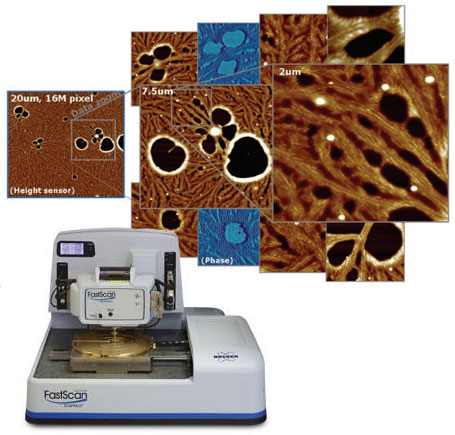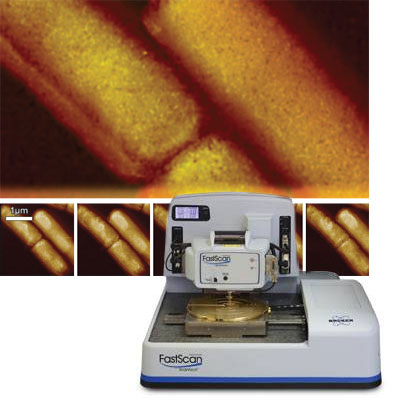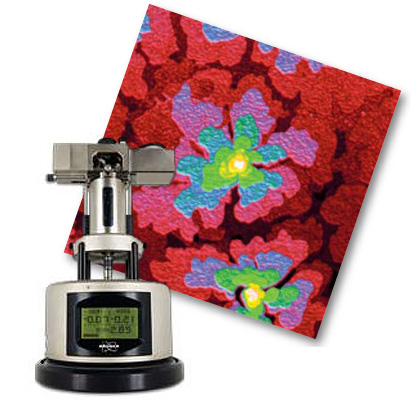High Resolution KPFM with Bruker PeakForce KPFM
KPFM (Kelvin Probe Force Microscopy – also known as Surface Potential Microscopy) is an AFM mode for measuring the work function of surfaces. It’s a commonly used analytical technique in corrosion research, photovoltaics, solar cells and surface analysis. Bruker’s PeakForce KPFM mode overcomes the common limitations of KPFM for higher resolution and greater sensitivity:
- Accurate, repeatable and sensitive work function measurements
- Highest spatial resolution and artefact-free potential contrast
- Correlated quantitative nanomechanical property mapping
Blue Scientific is the official distributor for Bruker AFM in the Nordic region (Denmark, Iceland, Norway, Sweden and Finland). If you have any questions, please get in touch.
Bruker Atomic Force Microscopes
KPFM Application Note
Contact us on +44 (0)1223 422 269 or info@blue-scientific.com
Kelvin Probe Force Microscopy
Kelvin Probe Force Microscopy (KPFM) maps electrostatic potential on the surface of your sample, to give you information about:
- Electronic structure
- Doping level variations
- Trapped charges
- Chemical identity
This is useful in research into organic photovoltaics, silicon and wide band-gap semiconductors, as well as other applications.
High Resolution KPFM
Bruker’s PeakForce KPFM module enhances KPFM by combining it with their exclusive high resolution PeakForce Tapping technology, an AFM mode with unique scan algorithms and probe technology.
This enables quantitative work function mapping at high spatial resolution. Sensitivity is greater, and without the usual artefacts from mechanical cross-talk.
- Highest spatial resolution and artefact-free potential contrast
- Accurate, repeatable and sensitive work function measurements
- Correlated quantitative nanomechanical property mapping
- Easy to use, with optimised results
PeakForce KPFM enables consistent measurement across different material types, with the most accurate probe-to-probe surface potential measurements.
It can also be combined with Bruker’s PeakForce Tapping QNM mode for simultaneous, correlated nanoscale topography, electrical and mechanical property mapping.
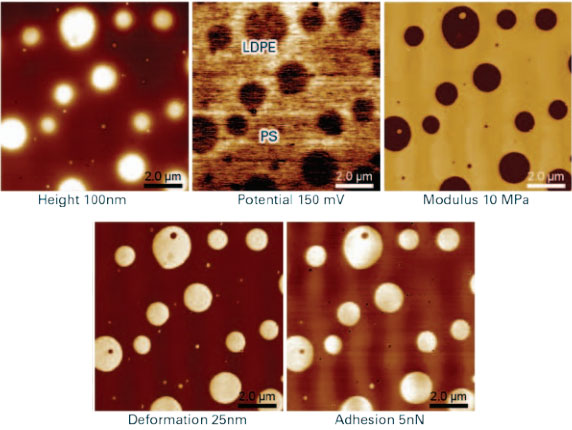
Polymer blend of polystyrene (PS) and low-density-polyethylene (LDPE). 10µm scan. Height, potential and quantitative mechanical property maps of Young’s modulus, deformation and adhesion.
Limitations of Standard KPFM
Conventional KPFM has several limitations, when using both amplitude and frequency modulation detection:
- Amplitude modulation (AM) lacks spatial resolution because of the cantilever’s contribution to the error signal.
- Frequency modulation (FM) lacks sensitivity and suffer from mechanical cross-talk.
These limitations are a particular problem for certain samples and studies, such as nanoscale structures with variations in modulus or adhesion. Setting up parameters can also be complex, which limits the consistency of results.
Overcoming Limitations
To overcome these limitations, Bruker’s PeakForce KPFM mode gives you the high spatial resolution of FM detection, while avoiding the common issues. This delivers consistent, quantitative work function measurements. Their patented LiftMode eliminates mechanical cross-talk. Unique technology delivers high resolution topography with the low-k, high-Q cantilevers that are required for high sensitivity.
PeakForce KPFM is able to resolve and quantify nanoscale work function variations that would usually be extremely challenging with conventional techniques. You can also collect directly correlated, quantitative, nanomechanical data with PeakForce QNM (Quantitative Nanoscale Mechanical Characterisation) mode.
In the example below, nanoscale phase segregation is clearly resolved. The potential channel shows accurate work function differences for the nanoscale domain. Using conventional AM detection these would have been underestimated by at least a factor of two. The adhesion image shows very fine phase structure with strong adhesion differences, which would usually remain ambiguous. LiftMode has removed any contamination from the potential signal, that may have been caused by adhesion differences. Property channels were acquired simultaneously.
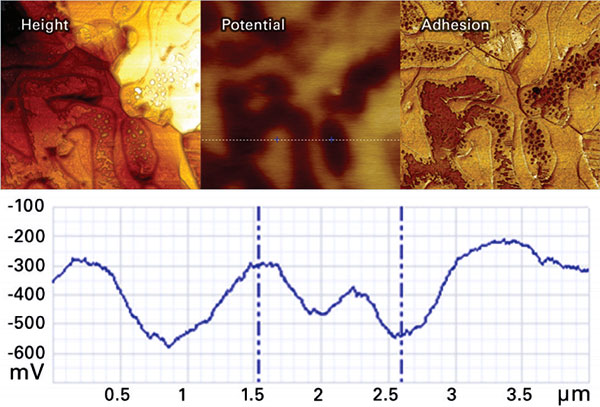
Quantitative work function measurements on a nanostructured Sn-Pb alloy (size: 4µm).
Complete KPFM Package
PeakForce KPFM includes all industry-standard KPFM implementations, together with a high-voltage mode. This enhances the potential range by a factor of >10, and gives you unmatched capabilities:
- Image potential variations in complex materials
- Study electronic structure in semiconductors
- Map chemical distribution with work function variation
- …and more
Easier to Use
Standard KPFM can be complex and tricky to set up. However, Bruker’s ScanAsyst mode features algorithms to automatically monitor image quality and adjust parameters for you, to give you the best results. This means that non-expert AFM users can achieve excellent quality results, and makes traditionally complex modes like KPFM much more accessible.
Instrumentation
PeakForce KPFM is available with these Atomic Force Microscopes from Bruker.
Further Information
More detailed information about KPFM, with technical diagrams and example results is available in this application note from Bruker:
Application Note
Blue Scientific is the official Nordic distributor for Bruker Nano Surfaces, and we’re available to answer all your questions and provide quotes. Please feel free to get in touch with any queries:


